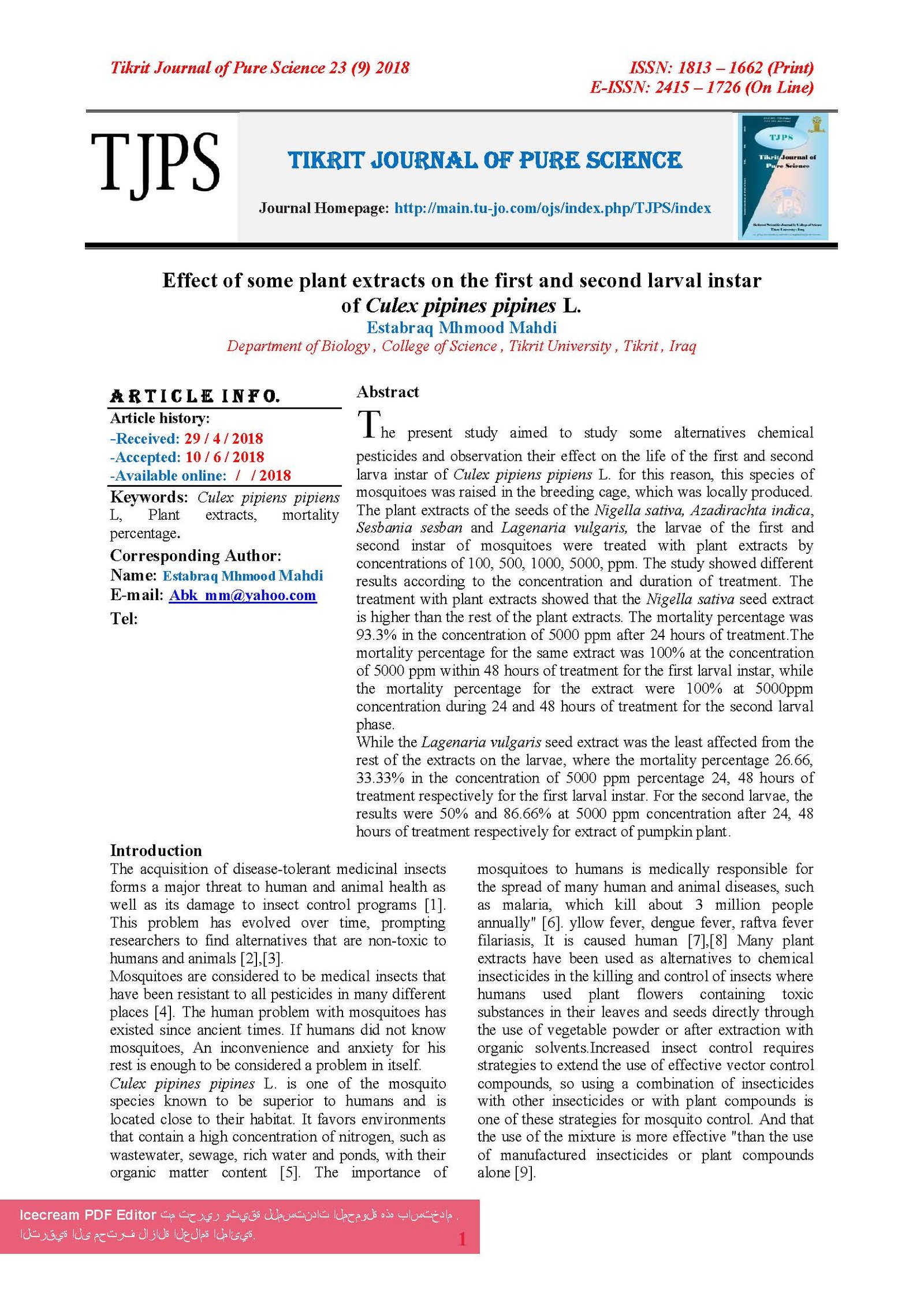Effect of some plant extracts on the first and second larval instar of Culex pipines pipines L
Main Article Content
Abstract
The present study aimed to study some alternatives chemical
pesticides and observation their effect on the life of the first and second
larva instar of Culex pipiens pipiens L. for this reason, this species of
mosquitoes was raised in the breeding cage, which was locally produced.
The plant extracts of the seeds of the Nigella sativa, Azadirachta indica,
Sesbania sesban and Lagenaria vulgaris, the larvae of the first and
second instar of mosquitoes were treated with plant extracts by
concentrations of 100, 500, 1000, 5000, ppm. The study showed different
results according to the concentration and duration of treatment. The
treatment with plant extracts showed that the Nigella sativa seed extract
is higher than the rest of the plant extracts. The mortality percentage was
93.3% in the concentration of 5000 ppm after 24 hours of treatment.The
mortality percentage for the same extract was 100% at the concentration
of 5000 ppm within 48 hours of treatment for the first larval instar, while
the mortality percentage for the extract were 100% at 5000ppm
concentration during 24 and 48 hours of treatment for the second larval
Article Details

This work is licensed under a Creative Commons Attribution 4.0 International License.
Tikrit Journal of Pure Science is licensed under the Creative Commons Attribution 4.0 International License, which allows users to copy, create extracts, abstracts, and new works from the article, alter and revise the article, and make commercial use of the article (including reuse and/or resale of the article by commercial entities), provided the user gives appropriate credit (with a link to the formal publication through the relevant DOI), provides a link to the license, indicates if changes were made, and the licensor is not represented as endorsing the use made of the work. The authors hold the copyright for their published work on the Tikrit J. Pure Sci. website, while Tikrit J. Pure Sci. is responsible for appreciate citation of their work, which is released under CC-BY-4.0, enabling the unrestricted use, distribution, and reproduction of an article in any medium, provided that the original work is properly cited.
References
[1] Shaaban, A and Al-Malah, N. M, (1993). Pesticides, Ministry of Higher Education and Scientific Research, Dar Al Kuttab for Printing and Publishing - University of Mosul - Iraq. P: 520.
[2] Saxena, S. C. and Yadav, R.S. (1983). A new plant extract to supperss the population yellow fever and denge vector Aedes. aegypti. L. (Diptera : Culicidae ). Current Sci. 52 (15):713 – 715 .
[3] Kim, S.; Roh, J. Y.; Kim, D.H.; Lee, H.S. and Ahn, Y.J. (2003) Insecticidal activies of aromatic Plant extracts and essential oils against Sitophilus oryzae and Callosobruchus chinensis. J. stor. Prod. Res..39: 293-303.
[4] Curtis, C.F and Pasteur. N. (1981). Organophosphate Resistance.
[5] Rahawi, H. M. (2000). Effect of pyrothroidin pesticide, insect growth regulator and some extracts in some roles of Culex pipiens L.(Diptera: Culicidae). MSc Thesis of Science, University of Mustansiriya, Iraq.
[6] Schmditt, W. C. (2005). Out smarting olfaction . The next Genration Mosquito Repellnts. Evironews . 113 (7): 468 – 471.
[7] Abu- alhub, J. (2004). Pathogenic insects. A 1: Press House of Cultural Affairs. Baghdad. pp 74-78.
[8] Bulletin, V. (2009). Jelsoft . Enterprises..3.8.9. Ltd. diseases of malaria . PP: 1-5.
[9] Shaalan, E,A.; canyon, D.V, Younes, M.W.; Abdel-Wahab, H. and Mansour, A. H. (2006). Synergistic efficacy of botanical blends with and without insecticides against Aedes aegypti and Culex annulirostris mosquitoes. J. vect. Ecol. 30 (2): 284-8.
[10] Mohsen, Z.H. and Mehdi, N. S. (1989). Effect of insect growth in hibitor alsystin on Culex quinque fascitus say. (Diptera: Culicdae). Insect. Sci. Appl. 10 (1) pp: 29-33.
[11] AL - Mohammadi, N. K. M. (2006). Studying the Extruding Effect of Plant Extracts of Castor Seeds Ricinus communis L. Peganum Harmala L. of Culex pipiens molestus (Forskal) Diptera: culicidae, MSc Thesis, College of Education, Anbar University, Iraq.
[12] Ladd, T. L.; Jacobson, M. and Buriff, C. R.(1978). Japanese beetles: Extract form neem tree Seeds as feeding deterrents. J. Econ. Entomol.
[13] Abdul-Jabbar, H. D. (2006). The biological effect of some plant extracts, Eruca sativa, Radhanus sativus and Lactuca sativa in the life of the Callosobruchus maculates F. (Coleoptera: Bruchidae), MSc Thesis, College of Education - University of Tikrit - Iraq
[14] Little, T.M. and Hills, F.J. (1972). Statistical methods bin agricultural research. Agricultural extension university of California. pp: 242.
[15] Sha'ban, A. and Al-Malah, N. M. (1993). Pesticides, Ministry of Higher Education and Scientific Research, Dar Al Kuttab for Printing and Publishing - University of Mosul - Iraq. 520 pp.
[16] Bowers, W.S. (1984). Insect Plant interactions : Endocrine. defences. Pitman book , London . 188 pp.
[17] Attri, B.S. and Parasd, R. (1980). Neem oil extractive on effective mosquito larvicide. Indian. J. Entomol; 42 (3): 371 – 374 PP.
[18] AL- Tikriti, Ahmed Ali Issa, (2001). The toxic effect of the extracts of Melia azedarach and Cyperus ratundus linn on the life of the Callosobruchus maculates F. (Coleptera: Bruchidae). MSc Thesis, College of Education - University of Tikrit – Iraq.
[19] Wilps, H.; Kirkilionis, E. and Muschenich. K. (1992). The effects of neem oil and azadirachtin of mortality flight activity, and energy metabolism of Schistocerca gregaria (Forskal) acomarision between Laboratory and field locusts. Comp. Biochem Physiol. 102 : 67 – 71.
[20] Nixon, P.H. (2000). Pesticide mode of action and metabolism.
[21] jlood, . M. S. (2011). The toxic effect of some plant products against mosquitoes Culex pipiens molestus Forskal. Master TSc, College of Science - University of Mosul - Iraq.
[22] Batra, C.P., Mittal, P.K., Adak, T. and Sharma. (1998). Efficay of neem oil water emulsion against mosquito immatures. Indian. J. of Malariol . 35 :15 – 12.
